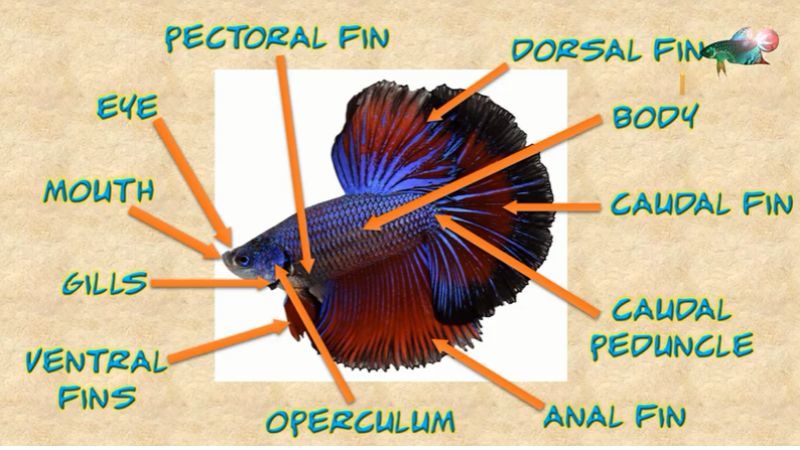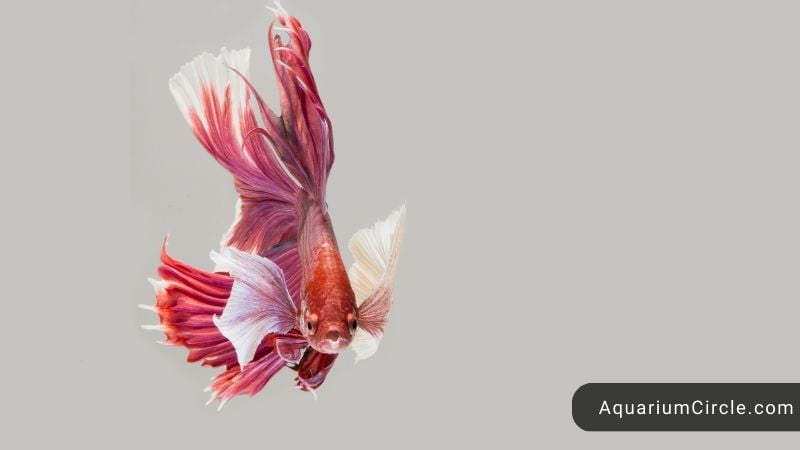Being a good caretaker includes being aware of your betta fish’s anatomy. Important anatomical characteristics of this remarkable species are highlighted in the image above. So it’s even more crucial to know about the betta fish anatomy. Male and female betta fish look remarkably alike and are difficult to distinguish. Males have depicted in the image above. However, both men and females have certain distinctive characteristics that we’ll discuss below.
Betta Fish Anatomy Differences Male And Female
In general, males have longer fins and a more pronounced body shape than females. The “caudal fin,” or distinctive flowing tail fin, is longer and more ornamented on males. Males have long, flowing fins, while females have shorter, rounder fins. Generally speaking, males have more dramatic patterns and brighter hues than females do.
Female bettas, however, can also have stunning color and patterning. Males are notorious for acting aggressively, particularly toward other male bettas. To intimidate their competitors, they will flare their gills and fins. Females can be maintained in groups and are typically quieter. On the underside of their bodies, female bettas have a tiny white patch called an “ovipositor” that is used to lay eggs. This area is absent in males. Whereas females are rounder and appear more robust, males have a more streamlined body form.
External Betta Fish Anatomy

The external anatomy of male and female betta fish comprises the following elements. They swim, feed, mate, battle, and do many other things! Let’s dissect the crucial areas and delve further into them, starting from the head backward.
The betta fish body shape
The body of a betta fish is extremely streamlined. Because of this, wild bettas could move through the water quickly and effectively while catching prey.
Betta fish mouth and teeth
You may have observed that betta fish have an upturned mouth, which permits it to catch prey floating on the water’s surface to reach oxygen from the air (such as mosquito larvae and other small insects). The betta’s mouth does have a few tiny teeth, but nothing sharp enough to harm a person. A bloodworm, however, would be a different story. You will soon witness a fish in combat, though!
Betta fish scales
The betta fish’s small scales serve as both protection for its body and a swimming help. A mucus layer on top of the fins provides additional defense, helping to ward off illnesses and parasites. You may have felt this slimy layer if you’ve ever handled fish. But, it’s crucial to avoid handling your fish excessively because doing so might damage the mucus layer, making your fish more susceptible to parasites and diseases.
Betta fish fins
Betta fish has some kinds of fins: ventral fins, dorsal fins, pectoral fins, anal fins, etc. Fish use their fins to balance themselves, move through the water, and stay stable. The fin that is used to propel the fish forward and provides the force for an abrupt burst of speed is the caudal fin (back betta fishtail).
The caudal fin has become longer over time thanks to selective breeding. But, compared to their wild predecessors, domestic betta fish move more slowly due to their longer, more delicate, more elegant tails. The anal fin and dorsal fin are there to give the fish stability. Together with the pelvic fins, the pectoral fins also add stability and aid in steering.
Gills
Water travels over the gills after passing via the mouth. The oxygen in the water is taken up by the blood passing through the gill capillaries. The gills of every fish is utilized to draw oxygen out of the water.
Eyes
They can focus on objects that are up to a foot distant, but their eyes do not adapt well to sudden changes in brightness. The eyes of the betta fish are definitely there for vision and sight. Monocular vision is the term for a betta fish’s vision. This indicates that each eye sees a different scene because their eyes are on different sides of their heads.
Internal Betta Fish Anatomy
The betta fish’s interior structure is intricate and interesting. The two-chambered heart of a betta fish is unusual among fish. Moreover, they possess a labyrinth organ, a unique respiratory system that enables them to inhale atmospheric oxygen straight from the air. Being surface breathers by nature, betta fish have a highly developed respiratory system.
Internal organs
This organ has developed as a result of the aquatic environments that betta fish have encountered in the wild. One of the few fish possessing a labyrinth organ is the betta. The betta fish can breathe oxygen from the air above the water’s surface thanks to this organ.
The fish can directly absorb air from the atmosphere into their bloodstream thanks to the labyrinth organ. Very impressive for a fish! Betta fish have evolved in shallow streams, marshes, and rice paddies. If these habitats dried up, the fish would lose access to the small pockets of anoxic water they needed to survive.
Swim bladder
Essentially, this bladder serves as a flotation device. To manage its buoyancy, the betta fish fills this with gas. When the betta fish is bloated, constipated, or overfed, the swim bladder may suffer. When this organ is compromised, it becomes difficult for the betta fish to go to the top of the tank where food and air are located (or sometimes hard for your betta to leave the top of the tank).
Stomach
The stomach of a betta fish is extremely small, about the size of its eye. Please avoid overfeeding your fish because it may result in swim bladder dysfunction. To help the food digest and lower the danger of bloating and constipation, many owners recommend a day without feeding every few days.
Operculum
The only function of their operculum is to cover and safeguard their delicate gills. The operculum serves as a protection cover for the gill tissues because they are very delicate and prone to harm.
Comparatively to female Bettas, the operculum of male Bettas protrudes far farther outward. I must say that betta fish is fighting fish. The “Betta beard,” a membrane that can be seen in subgroups of only men, is also covered by this operculum. These Bettas frequently flare their gill covers during combat to make themselves appear more intimidating and in charge.
Esophagus
Like people, fish have an esophagus that is connected to their mouth and passes food, water, and air through. Owners must be extremely picky about the food that their Bettas eat because even a minor cut sustained when consuming sharp food chunks might have a negative impact on their esophagus.
Liver
A Betta fish’s liver helps them store and absorb nutrients for use throughout the body. A specific enzyme called bile juice is secreted by this liver to aid in the digestion of the food. With the help of this enzyme, fish can digest even the most difficult diets without putting undue stress on their other organs.
Intestine
Before moving through the intestine, the food that you feed your Bettas is chemically processed in the stomach. The fundamental job of the gut is to transfer the nutrients from the food after it has been digested so that the body may absorb them. Prior to the remainder of the food being transferred to the final phase, it serves as a pathway for nutrient absorption.
Kidney
Similar to how your tank filter removes dirt and unwanted detritus, the kidney cleans out any contaminants in the bloodstream. The kidney maintains a healthy and completely working digestive system, enabling the fish to live longer. When bettas die from conditions like dropsy, they may have kidney failure.

Stomach and heart
While the stomach of a Betta contains all the little pellets that its owners feed them, the heart performs and regulates the function of blood circulation throughout the body. Owners should avoid overfeeding betta fish since their tiny stomachs (around the size of their eyes) make them vulnerable to disease.
Also, fasting helps with food digestion, further lowering the chance of constipation and bloating.
Betta fish bones
Do you believe that? Although we are not always in the same locations, the bones of betta fish are quite similar to those of humans. They fulfill the same purpose in providing protection, structural support, and the creation of immune cells in the bone marrow.
Moreover, they support the bodily cavity from the inside without reducing swimming ability. To support their fins and the muscles that propel their swimming motion, fish have several structural bones throughout their backs and tails. As almost all aquarium fish are “bony fish,” you can assume that every fish in your tank has bones. Sharks, stingrays, and other cartilaginous fish don’t have bones, in contrast to Betta fish. Instead, cartilage, a flexible but hard material similar to that found between your bones at joints, makes up their whole skeleton.
FAQs
Where are betta fish ears?
Betta fish do not have external ears. Instead, they have a unique inner ear structure known as the labyrinth organ, enabling them to hear and feel vibrations in the water. The labyrinth organ is situated beneath the brain and behind the eyes in the betta’s skull. It is made up of a network of sensory cells and fluid-filled tubes that cooperate to pick up sound and movement in the surrounding water. A crucial component of a betta’s anatomy, the labyrinth organ aids the fish in navigating its surroundings, finding food, and avoiding predators.
Why do betta fish make bubble nests?
When a male betta fish is ready to mate, he will build a bubble nest. They produce bubbles with their lips before collecting them to build a nest on the water’s surface. The bubble nest gives the eggs and newly hatched fry protection from predators and a secure environment in which to grow. Also, it’s thought that making a bubble nest is related to the betta’s innate desire to establish and protect a territory.
Do betta fish have a brain?
Yes. Indeed, betta fish are intelligent. While less sophisticated than those of mammals or birds, all fish have brains. Betta fish have a tiny brain in their head that controls their nervous system and manages all of their behavior, including swimming, eating, and reproducing. Betta fish have been seen to engage in various intelligent behaviors, including problem-solving, learning, and fish-to-fish interaction.
References:
- Betta Anatomy – https://bettasplendensfish.fandom.com/wiki/Anatomy
- Betta – https://en.wikipedia.org/wiki/Betta

Annette M. Chaney is an experienced marine biologist with over 20 years of experience as an aquarist and fishkeeper. She started her first aquarium at a young age, filling it with frogs and goldfish obtained from the ten-cent pet store.
Annette grew up caring for and breeding African Cichlids, which led to a hobby in high school that doubled as a profitable means. Attending Reed College gave her time to solidify herself as an accomplished aquarium caretaker with an eye for sales. After that, from 2009 – 2013, she studied at Roger Williams University – one of the most prestigious universities for Aquaculture and Aquarium in USA. She is the founder of AquariumCircle since 2010.
